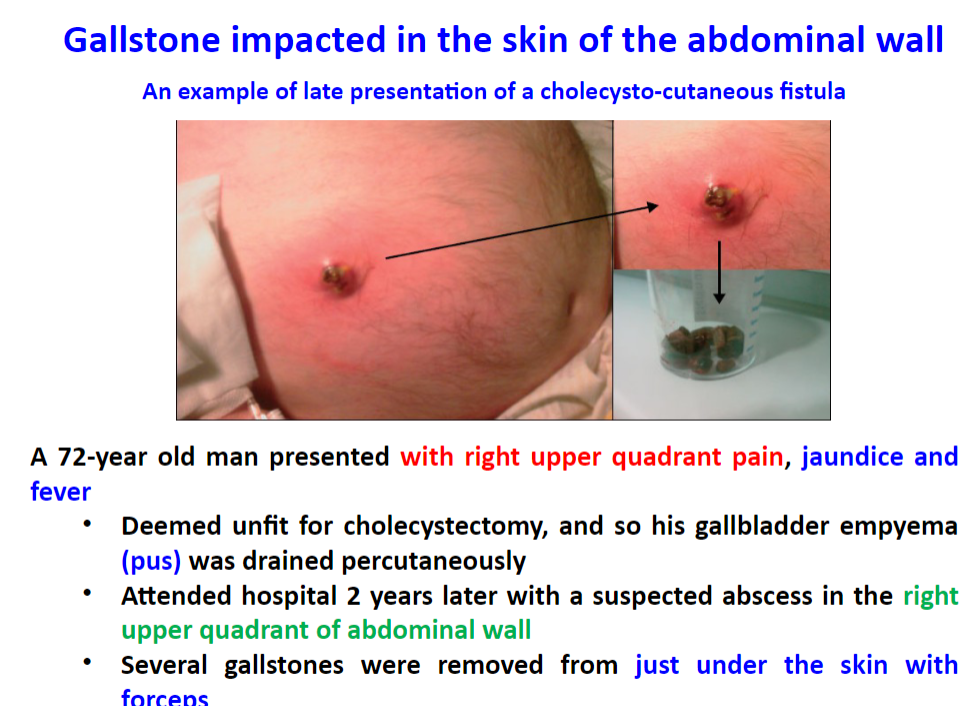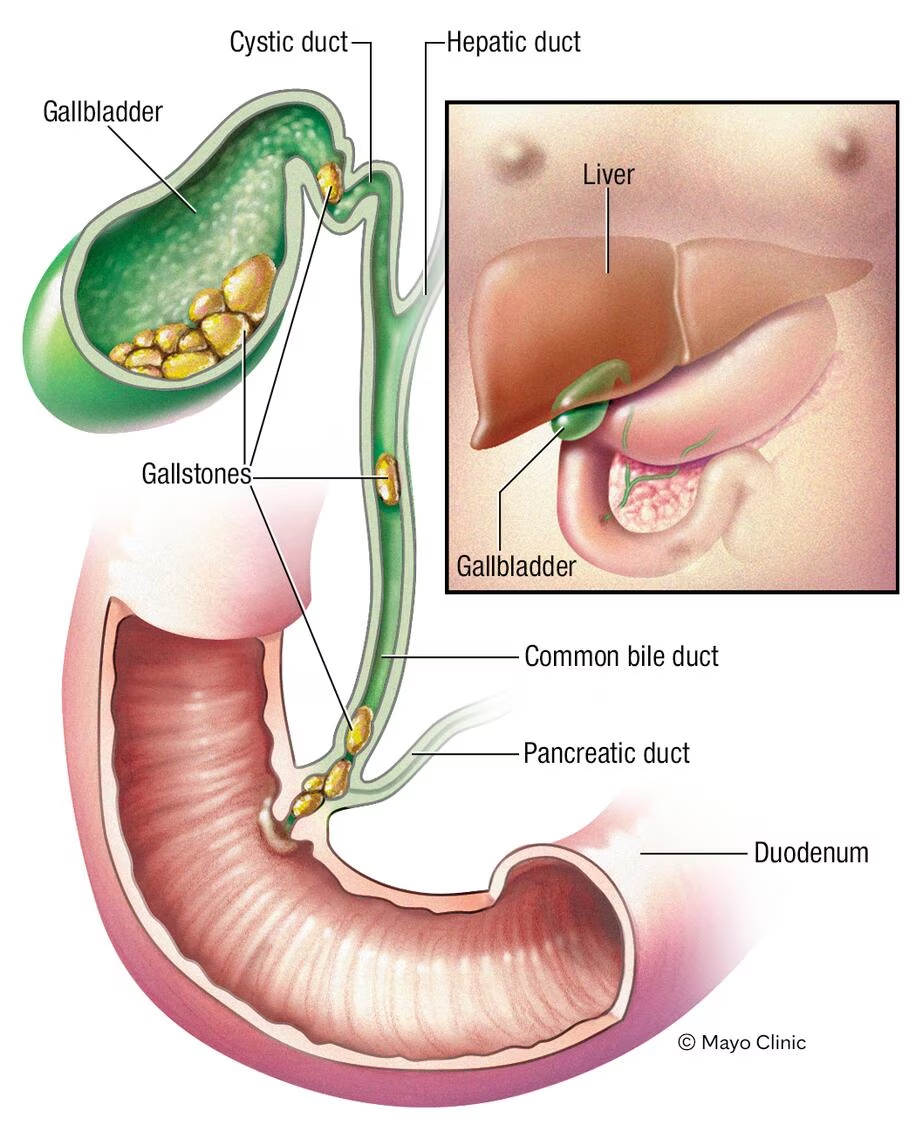
Bile, gallbladder and gallstones (Physiology)
Bile, gallbladder and gallstones - Dr Omar Janneh Session summary This lecture deals with the secretion of bile by the liver, the way in which it is handled by the gallbladder, the control of the gallbladder and the absorption of bile salts in the terminal ileum. The formation of gallstones is also discussed. Why it is important: Bile plays an essential role in the intestinal transport of fats. Gallstones/gallbladder disease are relatively common and often treated surgically. Learning outcomes At the end of this session you will be able to: The gross anatomy of the biliary system (gallbladder, hepatic cystic and common ducts, sphincter of the Oddi) and the relationship between the entry of the pancreatic and bile ducts into duodenum The digestive functions of the major constituents of bile The interaction between gallbladder motility and the opening of the sphincter of Oddi The control of gallbladder motility (in particular the role of the vagus and PZ-CCK) The composition of hepatic and gallbladder bile in terms of bile acids, bilirubin, bicarbonate and cholesterol concentrations The major constituent of small gallstones and factors leading to gallstone formation The possible clinical consequences of gallstones How and where bile acids are synthesised and the difference between primary and secondary bile acids The main functions of bile acids The metabolism of bile acids in the different parts of the enterohepatic circulation What is meant by the 'enterohepatic circulation'?
-
Picture demonstrating the gross anatomy of the billiary system:
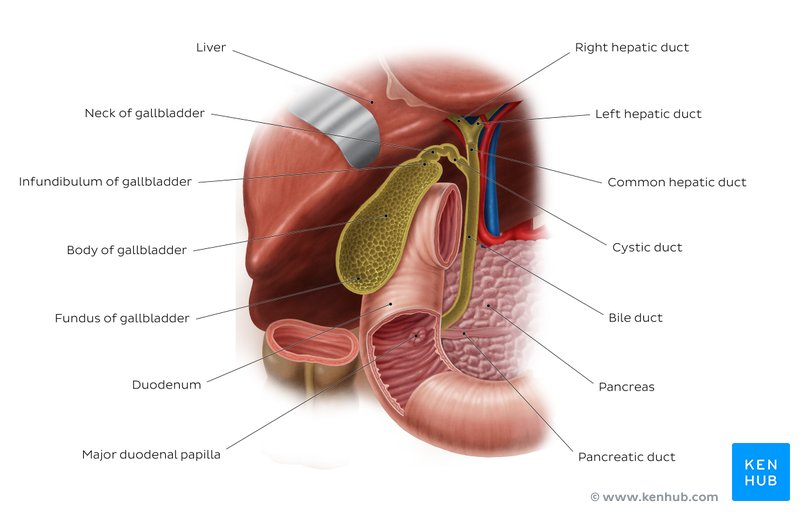
-
Picture demonstrating the overview of the billiary system:
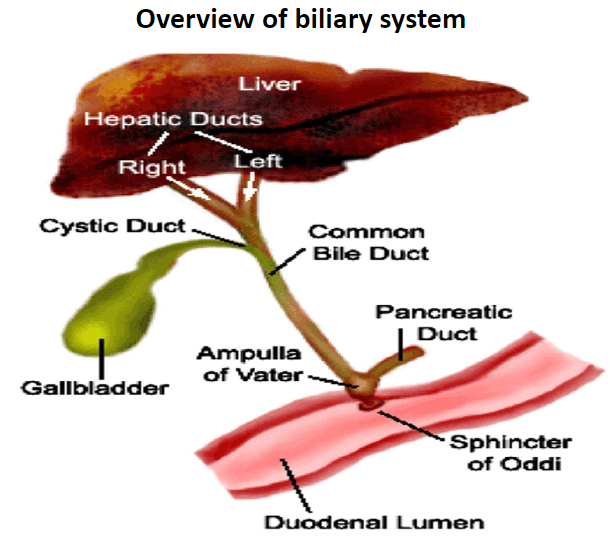
-
What are the primary functions of the gallbladder? (1)

★The gallbladder primarily functions in maintaining the storage and concentration of bile.
-
How does the gallbladder concentrate bile? (1)

★The gallbladder concentrates bile by actively transporting Na+ ions (and water) out of the bile, leading to its concentration.
-
What happens to the pH of bile during its storage in the gallbladder? (1)

★The pH of bile drops as Na+ ions are exchanged for H+ ions in the gallbladder.
-
What components are found in pancreatic juice? (1)

★Pancreatic juice contains bile salts, bile pigments, and dissolved substances in alkaline electrolytes.
-
How is water added to bile within the ductules? (1)
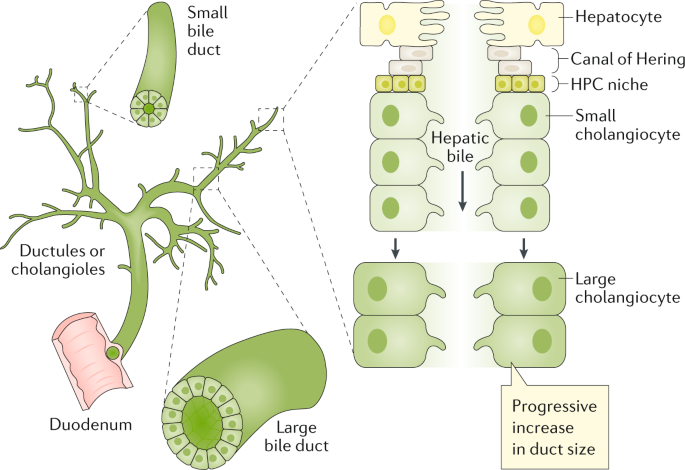
★Water may be added to bile via specific tight junctions within ductules, facilitated by cholangiocytes.
-
What substances do the ductules scavenge, and what process occurs with GSH? (1)
★The ductules scavenge glucose and amino acids, while GSH (glutathione) is hydrolyzed.
-
What does secretin trigger the ductules to secrete in the postprandial period? (1)
★In response to secretin in the postprandial period, ductules secrete IgA (for mucosal protection), HCO3- (bicarbonate ions), and water.
-
Outline the flow of bile from hepatocytes to the common bile duct. (1)
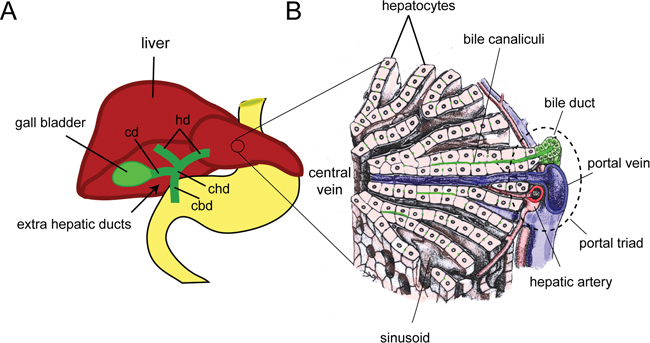
★Bile flows from hepatocytes to bile canaliculi, which merge to form ductules, then proceed to terminal bile ducts, hepatic ducts (left and right), and finally into the common bile duct.
-
Components of bile secreted by hepatocytes include (4):
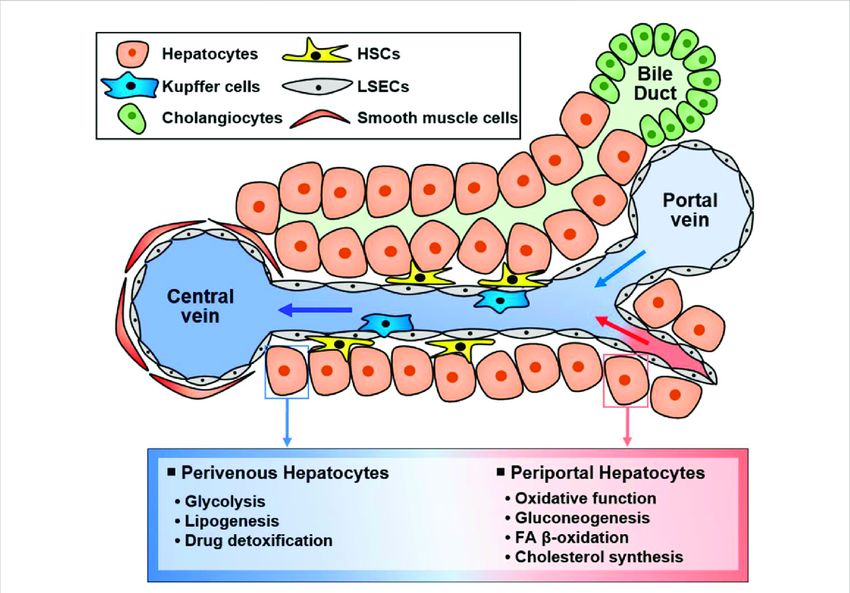
★Cholesterol, lecithin, bile acids, and bile pigments (such as bilirubin, biliverdin, urobilin, etc.).
-
Components of bile secreted by epithelial cells of bile ducts include (1):
★Bicarbonate-rich salt solution.
-
What influences the secretion of bicarbonate-rich salt solutions and water in bile? (1)
★Secretin and ACh influence the secretion of bicarbonate-rich salt solutions and water in bile.
-
When is bile secretion greatest? (1)
★Bile secretion is greatest during and after a meal.
-
How does the Sphincter of Oddi respond during fasting and after meals? (1)
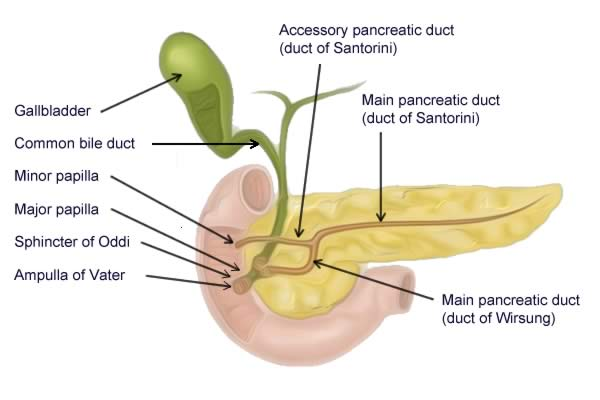
★The Sphincter of Oddi contracts during periods of fasting and relaxes during and after meals, stimulated by CCK (cholecystokinin).
-
Is bile essential for life? (1)
★Cholecystomised patients, who have had their gallbladder removed, can have a good quality of life, suggesting that bile may not be essential for life.
-
What substances are secreted across the bile canalicular membrane? (1)
★Substances secreted across the bile canalicular membrane include bile acids, phosphatidylcholine, conjugated bilirubin, cholesterol, and xenobiotics (foreign chemicals/substances, e.g., drugs).
-
How are bile acids, phosphatidylcholine, conjugated bilirubin, and cholesterol transported into bile? (1)
★Specific transporters ferry bile acids, phosphatidylcholine, conjugated bilirubin, and cholesterol into bile.
-
How do substances such as water, glucose, Ca2+, GSH, amino acids, and urea enter the bile? (1)
★Substances such as water, glucose, calcium ions (Ca2+), glutathione (GSH), amino acids, and urea enter the bile by diffusion.
-
What is the composition of hepatic bile? (1)
★Hepatic bile is composed of 97% water along with cholesterol, lecithin, bile acids, bile pigments, etc.
-
What is the composition of gallbladder bile? (1)
★Gallbladder bile contains 89% water along with bicarbonate ions (HCO3-), chloride ions (Cl-), calcium ions (Ca2+), magnesium ions (Mg2+), sodium ions (Na+), cholesterol, bilirubin, bile salts, etc.
-
How is bile concentrated in the gallbladder? (1)
★Bile is concentrated in the gallbladder through the loss of NaCl and water, leading to increased solid content.
-
When does bile flow to the gallbladder, and what condition ensures its flow? (1)
★Bile flows to the gallbladder between meals when the sphincter of Oddi is closed, allowing bile to accumulate and be stored in the gallbladder.
-
What are bile acids made from? (1)
★Bile acids are made from cholesterol, which also helps to reduce cholesterol levels in the body.
-
How are bile acids secreted into bile, and what are they conjugated to? (1)
★Bile acids are secreted into bile and conjugated to either glycine or taurine.
-
What are the major bile acids in human bile? (1)
★The major bile acids in human bile are glycine and taurine conjugated cholic acid and chenodeoxycholic acid.
-
What are the conjugated forms of cholic acid? (1)
★The conjugated forms of cholic acid are glycocholic acid (glycine conjugated) and taurocholic acid (taurine conjugated).
-
What are the conjugated forms of chenodeoxycholic acid? (1)
★The conjugated forms of chenodeoxycholic acid are glycochenodeoxycholic acid (glycine conjugated) and taurochenodeoxycholic acid (taurine conjugated).
-
What is the significance of bile acid conjugation? (1)
★Conjugation increases the amphipathic nature of bile acids, aiding in their secretion and decreasing their cytotoxicity.
-
What are bile acids conjugated with glycine or taurine also called? (1)
★Bile acids conjugated with glycine or taurine are also called bile salts.
-
What are the two primary bile acids found in humans, and what are their relative percentages? (1)
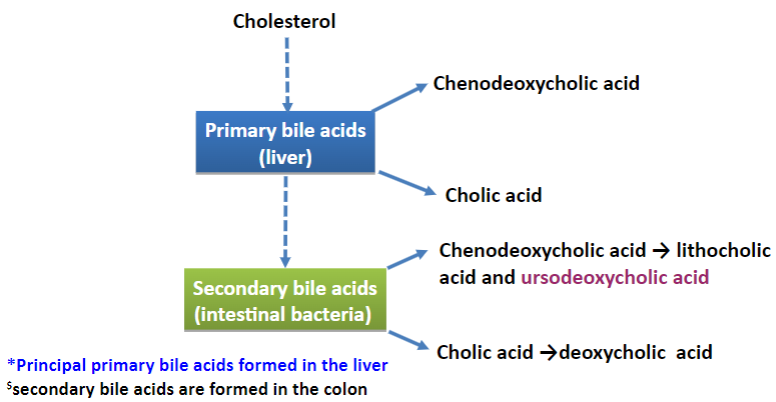
★The two primary bile acids found in humans are cholic acid (50%) and chenodeoxycholic acid (30%).
-
What are the two secondary bile acids found in humans, and what are their relative percentages? (1)
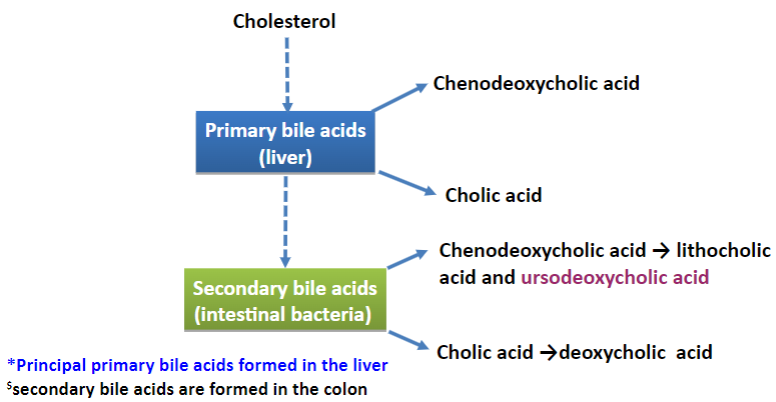
★The two secondary bile acids found in humans are deoxycholic acid (15%) and lithocholic acid (5%).
-
What is the main function of bile acids in relation to cholesterol elimination? (1)
★Bile acids aid in the elimination of cholesterol by converting it into bile acids, with 5% excreted in feces, which represents a significant mechanism for the elimination of excess cholesterol.
-
How do bile acids contribute to reducing cholesterol precipitation in the gallbladder? (1)
★Bile acids and phospholipids help solubilize cholesterol in the bile, reducing its precipitation in the gallbladder.
-
What role do bile acids play in the absorption of fat-soluble vitamins? (1)
★Bile acids facilitate the absorption of fat-soluble vitamins A, D, E, and K.
-
How do bile acids regulate their own transport and metabolism? (1)
★Bile acids regulate their own transport and metabolism via enterohepatic circulation.
-
How do bile acids facilitate the digestion of triglycerides? (1)
★Bile acids facilitate the digestion of triglycerides by acting as emulsifying agents that render fats accessible to pancreatic lipases.
-
What stimulates gallbladder contraction during the cephalic phase? (1)
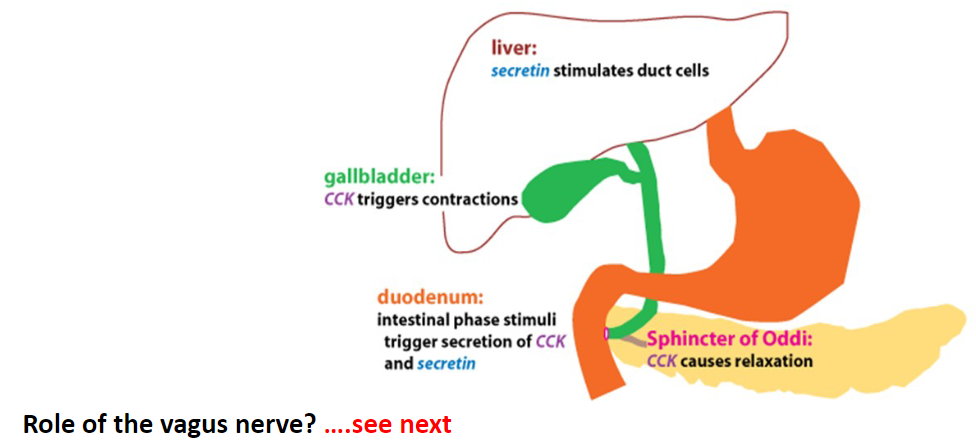
★Impulses via the vagus nerve triggered by taste, smell, and the presence of food in the mouth stimulate gallbladder contraction during the cephalic phase.
-
What stimulates gallbladder contraction during the gastric phase? (1)
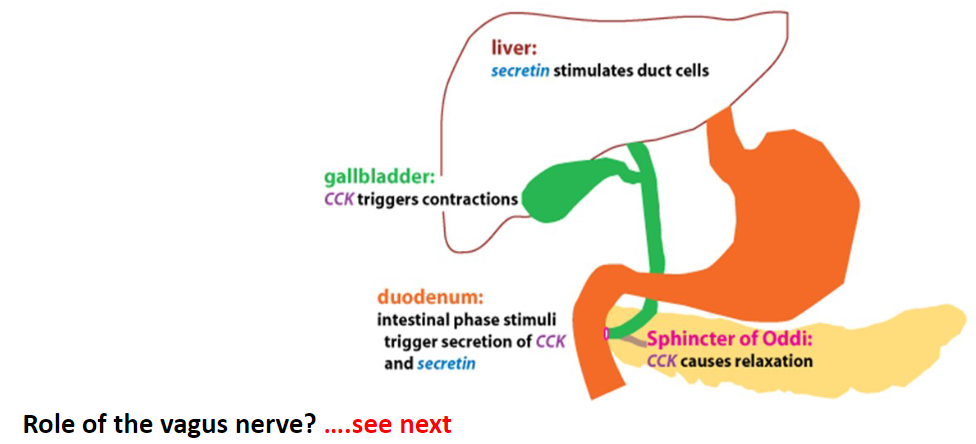
★Gallbladder contraction during the gastric phase is stimulated by impulses generated in the vagus nerve due to the distension of the stomach.
-
During the intestinal phase, what are the key mediators for increased gallbladder emptying? (1)
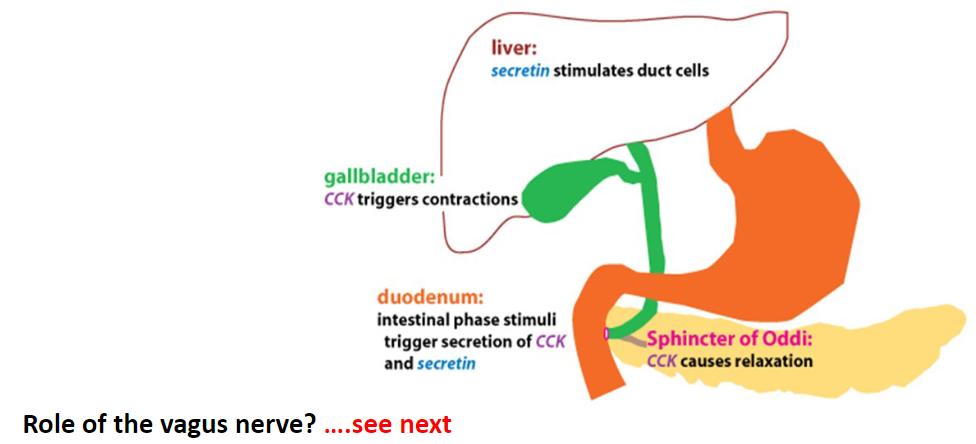
★Cholecystokinin (CCK)
★Secretin
-
Picture demonstrating the Mechanisms controlling the secretion of bile into the duodenum
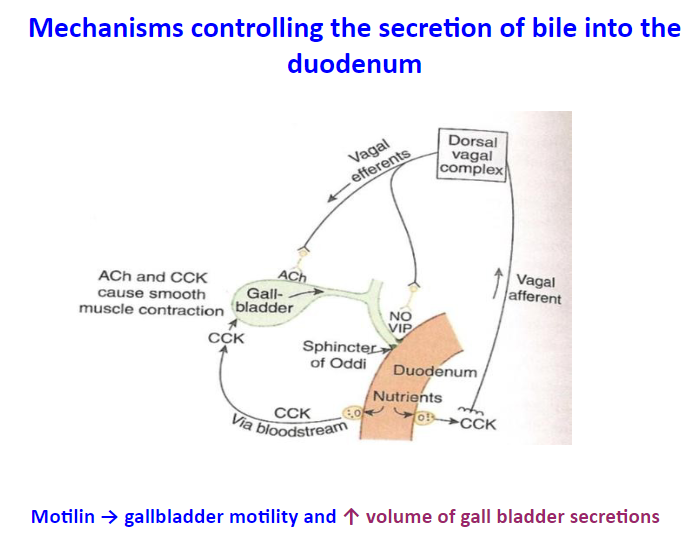
-
Picture demonstrating What controls the contraction of the gallbladder and the release of bile into the duodenum:
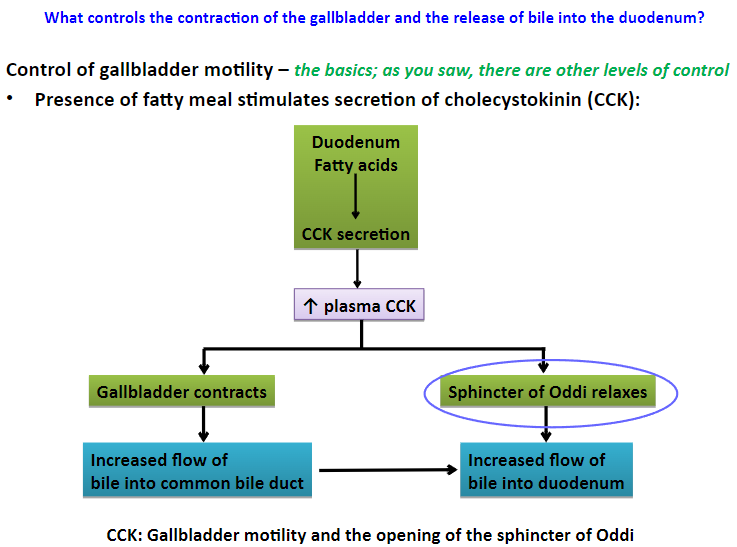
-
Picture demonstrating A near all-embracing model which explains the release of bile into the duodenum:
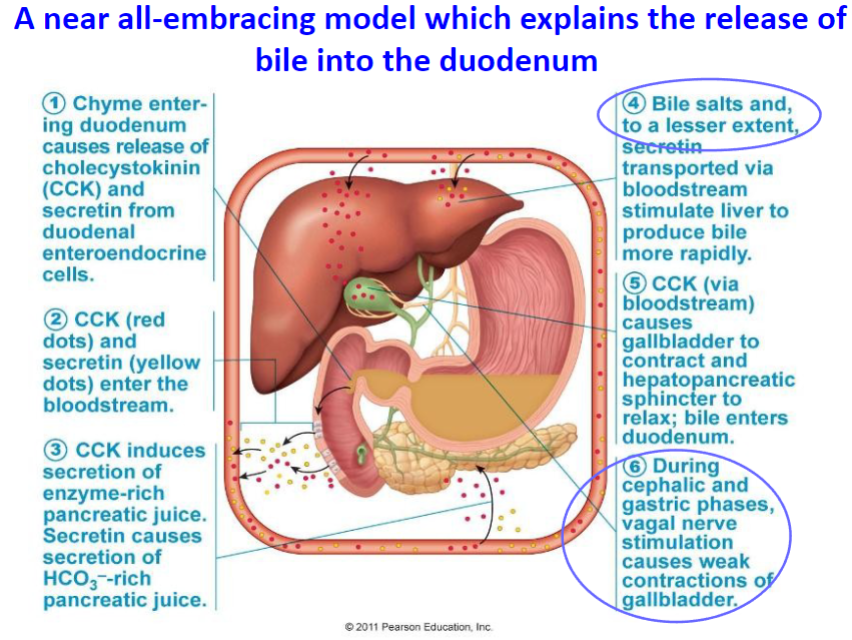
-
What substances are synthesized in the liver and contribute to bile secretion? (1)
★Bile salts and lecithin (phospholipids) are synthesized in the liver and contribute to bile secretion.
-
What is the role of HCO3- and other ions in bile secretion? (1)
★HCO3- and other ions in bile help neutralize acids in the duodenum.
-
Why are bile salts considered the most important in gastrointestinal function? (1)
★Bile salts are considered the most important in gastrointestinal function due to their role in emulsifying fats and aiding in fat digestion and absorption.
-
How are bile salts recycled in the body? (1)
★Most bile salts (95%) are reabsorbed by Na+-bile salt coupled transporters and returned to the liver for secretion into bile, forming the enterohepatic circulation.
-
What is enterohepatic circulation? (1)
★Enterohepatic circulation refers to the cycling of bile from the intestine to the liver and back to the intestine, facilitating the recycling of bile salts.
-
How many times per meal may the body's content of bile acid pool be recycled? (1)
★The body's content of bile acid pool (~3.5g) may be recycled approximately twice per meal.
-
What does the liver secrete into the bile, and what happens to some of it? (1)
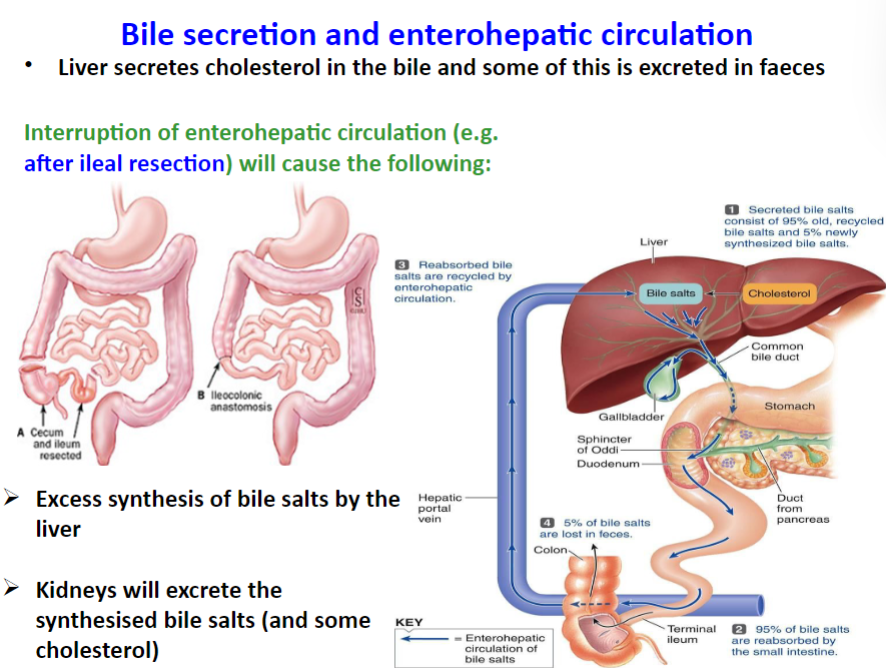
★The liver secretes cholesterol into the bile, and some of it is excreted in faeces.
-
What are the consequences of interrupting enterohepatic circulation, such as after ileal resection? (2)
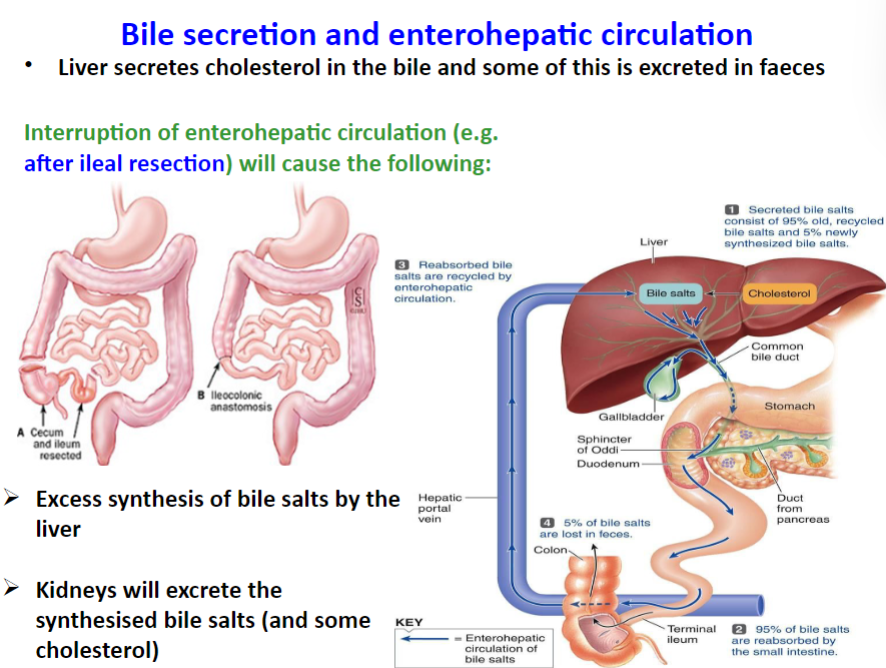
★Interruption of enterohepatic circulation leads to excess synthesis of bile salts by the liver.
★The kidneys will excrete the synthesized bile salts (and some cholesterol).
-
What is the ratio of incidence of gallstones in women and men, and how does incidence change with age? (1)
★The ratio of incidence of gallstones is 2:1 in women and men, respectively, and the incidence increases with age.
-
What are gallstones composed of? (1)
★Gallstones are composed of bile salts (bile compounded with a cation, e.g., Na+), cholesterol, and phospholipids.
-
What factors contribute to the increased cholesterol content of bile, leading to gallstone formation? (1)
★Excess secretion of cholesterol by the liver and reabsorption of salt and water contribute to the increased cholesterol content of bile, which leads to gallstone formation.
-
How do gallstones form? (1)
★Cholesterol crystallizes and forms gallstones, which may also involve the precipitation of bile pigments.
-
What are the two types of gallstones, and what are their respective associations? (2)
★Cholesterol stones (85%): Associated with obesity, decreased bile acids, and decreased phospholipids.
★Calcium bilirubinate stones: Due to increased conjugated bilirubin, often associated with hemolytic anemia.
-
What factors are involved in gallstone formation? (5)
★Bile stasis: Stones form in stagnant bile in the gallbladder rather than bile flowing in the bile ducts into the duodenum.
★Decreased amount of bile acids: Due to malabsorption (e.g., in cystic fibrosis or Crohn's disease), leading to higher incidence.
★Chronic infection: Bacteria aid in the formation of pigment stones.
★Super-saturation of bile with cholesterol.
★Presence of nucleation factors or glycoproteins.
-
What are the findings from ex vivo studies regarding gallstone formation? (1)
★Bile from gallstone sufferers forms stones within 2-3 days, while bile from normal individuals takes approximately 2 weeks to form stones. This delay may be due to the presence of anti-nucleation factors.
-
What happens if small gallstones form? (1)
★Small gallstones can easily pass through the bile duct.
-
What occurs when larger gallstones lodge in the opening of the gallbladder? (1)
★Larger gallstones that lodge in the opening of the gallbladder cause right upper quadrant pain and jaundice.
-
How does the lodging of gallstones affect bile and pancreatic secretions? (1)
★Lodging of gallstones at the point where the pancreatic duct joins the bile duct can stop the flow of both bile and pancreatic secretions, leading to pressure build-up, right upper quadrant pain, and jaundice.
-
What are the consequences of decreased bile secretion? (1)
★Nutritional deficiency may occur as digestion of fats becomes inefficient due to decreased bile secretion.
-
What gives bile its yellow colour? (1)
★Bile is yellow because of bilirubin.
-
What is the color of urine due to increased bilirubin accumulation? (1)
★Increased accumulation of bilirubin in the blood causes jaundice, giving urine a darker colour.
-
What colors feces? (1)
★Stercobilin, derived from bilirubin, colours faeces.
-
What causes right upper quadrant pain and jaundice? (1)
★Increased pressure build-up due to gallstone lodgment can cause decreased secretion of bile, resulting in right upper quadrant pain and jaundice.
-
What imaging techniques are used to visualize the gallbladder and detect gallstones? (1)
★Ultrasonography and computer tomography (CT) are used to explore the right upper quadrant of the gallbladder to detect gallstones.
-
What is the purpose of cholescintigraphy? (1)
★Cholescintigraphy involves administering a technetium-99m-labeled derivative of iminodiacetic acid (radioactive tracer) to acquire images of the gallbladder and ducts.
-
How is the biliary tree visualized in endoscopic retrograde cholangiopancreatography (ERCP)? (1)
★Contrast media is injected from an endoscope channel during ERCP to visualize the biliary tree.
-
Besides imaging, what other procedure can be done to address gallstone obstruction? (1)
★Inserting devices to remove gallstone fragments that may be obstructing bile flow, pancreatic juice, or both is another approach to manage gallstone obstruction.
-
What percentage of gallstone cases are asymptomatic? (1)
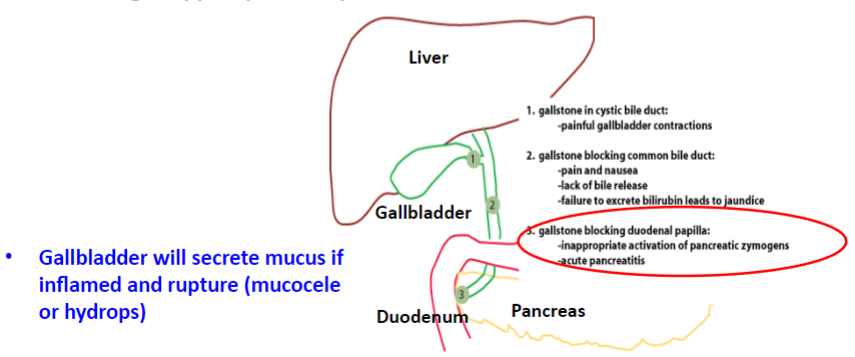
★85% of gallstone cases are asymptomatic, meaning the gallstones remain in the gallbladder without causing symptoms.
-
What clinical feature ensues if the neck of the cystic duct is impaired? (1)
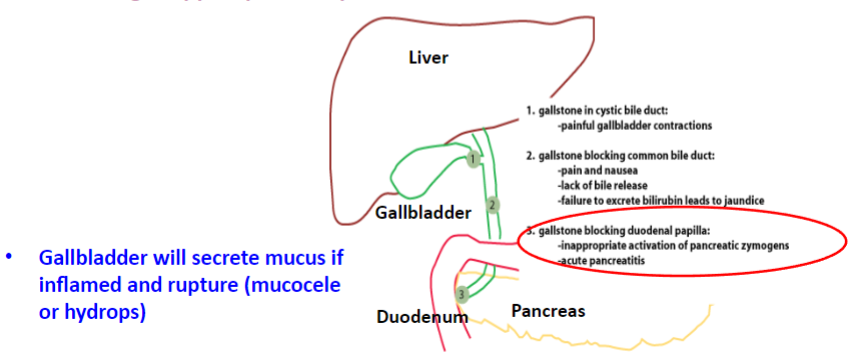
★Impairment of the neck of the cystic duct can lead to biliary pain in the right upper quadrant, a condition known as acute cholecystitis.
-
What happens if gallstones impact the common bile duct? (1)
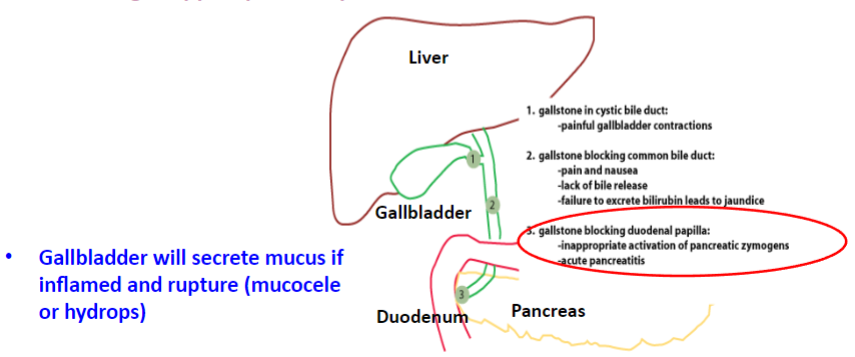
★Gallstones that impact the common bile duct can cause obstruction of bile flow and cholestatic jaundice, leading to potential complications such as bacterial infections (cholangitis) and right upper quadrant pain.
-

Picture demonstrating a Gallstone impacted in the skin of the abdominal wall:
